SALT LAKE CITY — A tiny pilot program that began with 50 students will celebrate its 10th anniversary this fall as a colossal global institution with at least 45,000 students and a mushrooming global footprint.
The little startup turned into a leviathan by using two major innovations to fuel one of the fastest-expanding phenomenons in higher education in the United States and 133 other countries.
BYU-Pathway Worldwide now offers a full private college education to U.S. students for less than $8,760. BYU-PW tuition prices drop even lower — often far lower — in other countries, providing opportunities for a university education to capable students who before could only dream of them.
In relative terms, BYU-PW is an overnight sensation, taking just a decade to surpass its 144-year-old sister school, Brigham Young University in Provo, Utah, to become the largest institution of higher education in the educational system of The Church of Jesus Christ of Latter-day Saints.
American higher education is in trouble. Steadily rising costs. Searching questions about return on investment. Burgeoning student debt. A dropout rate of 89 percent for those in the bottom quartile of income. The problems may deepen. Headlines like “The Higher Education Apocalypse” report the closures of colleges and universities amid some experts’ predictions that half will close or go bankrupt in the next decade.
So why are some schools expanding rapidly? And how has BYU-Pathway Worldwide forged a place among other incubators of disruptive innovation in higher education, mega-colleges like Southern New Hampshire University with its 135,000 students, including a growing number in refugee camps in Africa and the Middle East.
BYU-PW has built a unique bridge from its unique entry-level program, PathwayConnect, to the online degree program at one of its sister schools, Brigham Young University-Idaho. It also leverages its ability to tap into the existing infrastructure of its sponsoring church.
BYU-Pathway’s draw goes beyond the low price. It has created an entirely new category in its sponsoring church’s education system by connecting to a unique set of students in ways that are cultivating intense loyalty.
”What BYU-Pathway Worldwide fundamentally recognizes is that the old notion that there was sort of one pathway into college is not the norm any more,” Southern New Hampshire University President Paul LeBlanc says. “They’re really helping shape a much more fluid, adaptive, diverse form of higher education.”
In the words of BYU-PW President Clark Gilbert, the school is serving the hidden many.
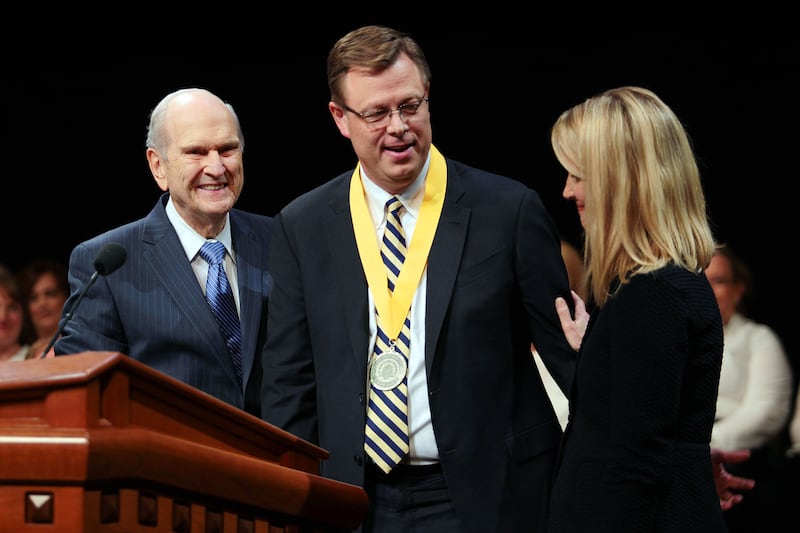
The question is, what is the secret sauce behind BYU-PW’s success at enabling at-risk students to start a college education and then persist until they earn certificates or degrees?
Stopouts and skeptics
Samoa’s Upolu Island is small enough that a visitor always seems to be either close to the surrounding Pacific Ocean or to the flourishing green rainforest at the island’s center. Fruit trees abound, even in the center of the capital city of Apia.
Lani Moors-Smolik, 44, lives closer to the rainforest, where she wakes at 6 a.m. and rouses Lauren, 17, and Owen, 11. They pray for Ian, 20, and his church missionary service in Tokyo, prepare for the day and leave by 7:15 a.m. for work and school closer to the ocean.
Born in Hawaii and raised stateside, Moors-Smolik dropped out of college as a young woman when she landed on academic probation after three semesters. As she raised her children, she became an indispensable workaholic who repeatedly bumped up against advancement ceilings that required degrees. By 2016, the bright, hard-working woman was in Samoa running a human resources office responsible for 250 people but again couldn’t advance without more education. When BYU-Pathway Worldwide reached Samoa’s shores three years ago, Moors-Smolik practically beat down its doors. She enrolled in the first class on the island.
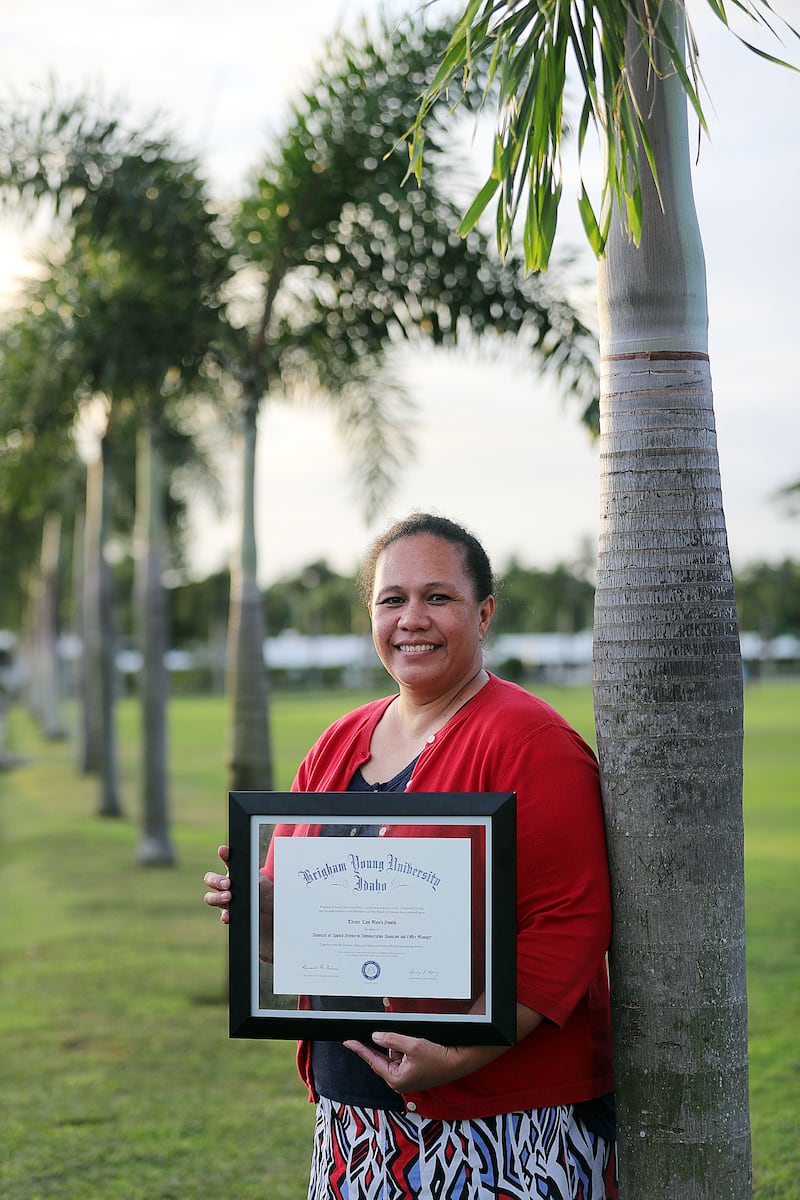
Gilbert shuns the word dropout. He applies the term stopout to refer to Moors-Smolik and hundreds of thousands like her, but he admits that they absolutely were not on the minds of the five people who met in November 2008 to consider the germ of the idea that has become BYU-PW.
Gilbert and J.D. Griffith were in the meeting. Griffith said the small group was focused on a different problem. They were looking at data that showed a swelling wave of children in The Church of Jesus Christ of Latter-day Saints that soon would break over the enrollment caps of the faith’s four colleges and universities. The question in the room was, how can we take the church’s higher education experience to the students who won’t fit on the church’s campuses?
”We thought we were trying to reach our normal target market, typical 18- to 25-year-olds, who couldn’t come to BYU-Idaho,” says Griffith, BYU-PW’s original managing director and now vice president of administration.
”Our definition was way too narrow,” Gilbert says.
They were about to find out just how many were among the hidden many, and it would drive how they would innovate.
First clues
Griffith called the director of the church’s Institute program at Boise State University and asked if any college-age students attended the program’s gospel classes but didn’t attend the university. The answer — “Yes, hundreds” — rocked him.
Griffith’s marketing background kicked in; he set up some focus groups.
Gilbert and Griffith hosted one in Manhattan, advertising it as a workshop on how adults could get a church education in New York City. As the meeting began, Gilbert leaned over to Griffith to say he was impressed that the church’s Lincoln Center chapel was packed and that so many local church leaders in their 30s and 40s and 50s had come to support the college-age church members.
His assumption was terribly wrong. He and Griffith had stumbled on the first of the hidden many.
”It wasn’t five minutes into the focus group that we realized they all were asking, ‘Can I do this?’” Gilbert says. “We found a branch president who was cleaning high rises at night while managing a whole congregation, collecting tithing and extending leadership callings to members but was told by the higher education system he didn’t belong. We found immigrants in New York on short stays who asked, ‘Can I do this when I go back to Haiti? Can I do this when I go back to Jamaica?’ We found nonmembers who said, ‘I don’t know if I can join your church or not, but can I do it?’ We found moms who said, ‘Johnny’s not attending church, can he do it?’
”In those very first focus groups, the church cried out to us, ‘The hidden many are more than you thought.’”
Gilbert and Griffith began to expand beyond teenagers who graduated high school and didn’t head to a college campus. They added adult learners, people outside the church and people inside the church who weren’t actively participating in it. The focus groups taught them that yes, price was a mammoth stumbling block. But so was a lack of confidence among stopouts and those who never started because of anxiety about taking the ACT or SAT or because they were told or thought that college wasn’t for them.
Global footprint
Meanwhile in Samoa, Moors-Smolik still remained off their radar.
Then, in October 2009, BYU-Idaho President Kim B. Clark, who had been a part of the initial meeting by phone and who oversaw the pilot program, called Griffith from the church’s semiannual general conference with direction from the faith’s leaders. We are taking this international, he said.
Griffith, who was in charge of logistics, put his head in his hands. The former associate athletic director at Washington State University now was going to help take the little startup to the world.
The increasingly global nature of BYU-PW obscures its unique place in American higher education.
In fact, nearly 10,000 Utahns enrolled in BYU-PW programs in 2018. Utah has a robust higher education system that offers a vast suite of public and private certificates and degrees on campuses and via online offerings that are very affordable relative to the rest of the U.S. system.

So why is Pathway, which relocated in 2017 from its incubation site at BYU-Idaho to the BYU Salt Lake Center in downtown Salt Lake City, so big in its home state?
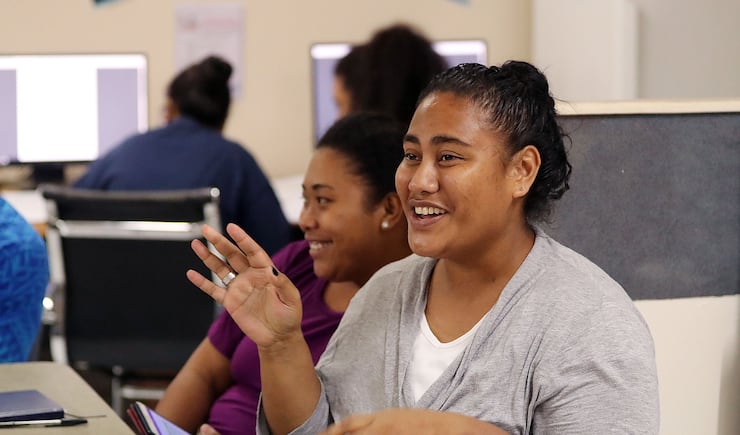
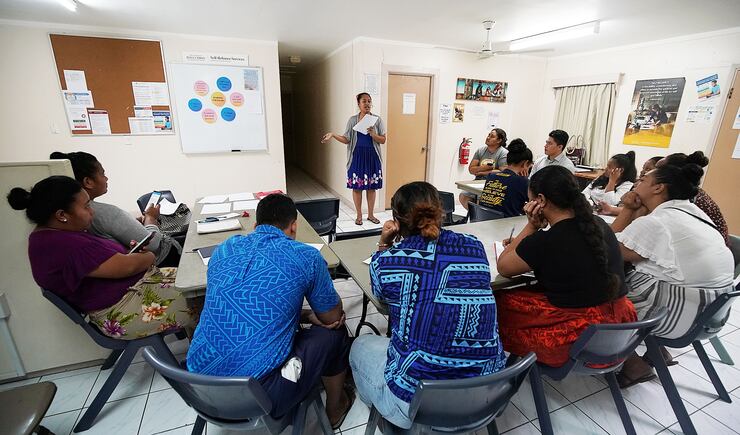
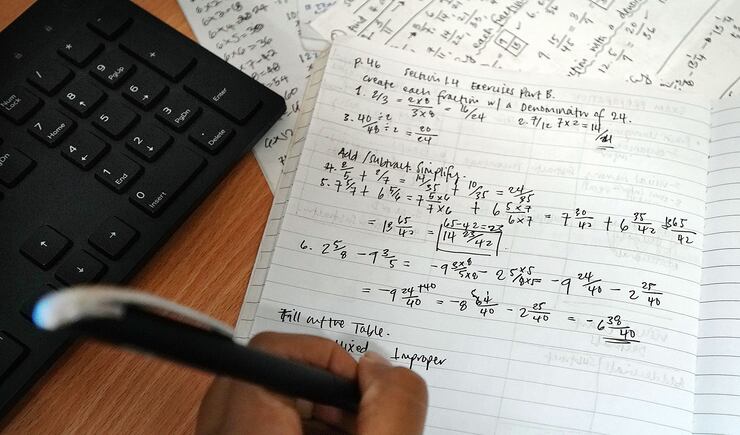

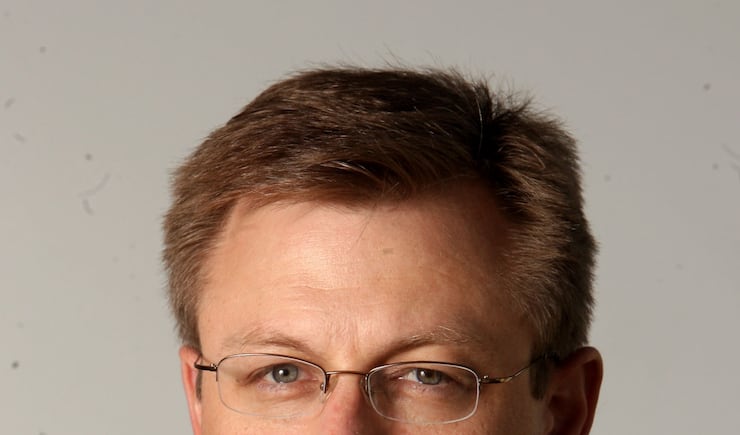
Gilbert is adamant. BYU-PW’s students are hidden even from Utah’s schools. BYU-PW is not taking students from other schools and programs. It is serving a new educational category.
First innovation
Gilbert is a disciple of innovative disruption who studied and taught the business theory at Harvard University.
”The real story of disruption is not destruction,” he says. “It’s always a vehicle for growth. Students aren’t choosing BYU-Pathway Worldwide over BYU-Idaho. They’re choosing BYU-Pathway Worldwide over not having an education.”
The road did have rocks in it.
”When we first started, we were sending students into the general education programs,” Gilbert says. “It was a disaster.”
BYU-PW has introduced two disruptive innovations that appeal to this new category of students and prepare them for higher education. The first was implemented from the start. The second was considered early on but not implemented fully until recently.
Gilbert uses the term “scaffolding confidence” to describe the first innovation. He means that BYU-PW has created new methods to help students recognize that they do in fact belong and can succeed in higher education.
”Many say the key is to make college affordable and lower standards,” Gilbert said. “We say, build student confidence. This idea that ‘you’re not college material’ is just false doctrine. A lot of this is just waking students up to how they can do it.”
Stanford University education professor Eric Bettinger said that the on-ramp at most American colleges and universities is short and steep, meaning that for many students it can be incredibly intimidating to try to enter the highway speeds of higher education. At least half of students arrive without the skills they need to be successful, he said.
”Pathway is fully structured around providing a customized solution to that,” he said. “It takes longer to go through Pathway than to go through the short on-ramp at other schools, but Pathway has the patience, it has the support, it has the low financial commitment many students who have not been served before really need.”
BYU-PW students begin in the one-year PathwayConnect program. PathwayConnect is what the original 50 students started in the pilot 10 years ago. The program does not require an ACT or SAT test, and students do not need the ecclesiastical endorsment required at other church schools. Students enroll in two classes per semester for three semesters. The six classes include three religion courses and one each in life skills, professional skills and university skills. The latter three classes include math and writing skills.
The students take the courses online, but in a unique twist, they also meet once a week in small groups. It is in those meetings that PathwayConnect builds student confidence. Students take turns leading class discussions while providing each other with encouragement and support. As students gain confidence in themselves, they also gain confidence in BYU-PW.
In his new book, “The College Dropout Scandal,” author David Kirp cited a recent study that showed the most powerful predictor of increased academic confidence was students’ perception of their school’s support for their academic, personal and social needs.
”In short,” he wrote, “the more students believe that they belong, the better they do academically.”
Most of online learning is still figuring out how to help students in different areas connect with others locally, says Michael Horn, co-founder of the Clayton Christensen Institute, a nonprofit think-tank dedicated to the theory of disruptive innovation.
”What’s interesting about BYU-Pathway in particular is there is a local element,” he says. “So it’s not just the online piece, but it’s also the community into which you get acclimated and plugged into as a learner. That becomes an incredible support structure for you. It seems like BYU-Pathway has navigated that dynamic quite well.”
The results
In addition to the organic support network created by the small classes, 92% of students report feeling more confident after the year of PathwayConnect.
”Most colleges take students like ours and put them in remedial training. We tell ours, ‘We’ll put you to work, and once you start, you’ll learn what you’re capable of.’ They suddenly realize they can do far more than they ever thought possible, Gilbert said.”
Remember that 89% dropout rate for low-income students. Instead of graduating 11% like the national average, “We’re four times better than the national profile with the same, at-risk students,” Gilbert says.
Some 56 percent complete the year of PathwayConnect. Of those who do, 95% earn a B average. That qualifies them for cheaper tuition, $73 per credit, in BYU-Idaho’s online degree programs, which are subsidized by the church and require an endorsement from an ecclesiastical leader.
Some might think that price is a disruptive innovation of its own. The standard bachelor’s degree in American online education costs nearly twice as much at $15,000. Some private schools now charge as much as $450,000 for a four-year degree. Meanwhile, American students who borrow are leaving college with an average of $30,000 in debt, according to the Brookings Institution.
Students scared by stories of life-altering debt have flocked to BYU-PW even when they live in places rich with educational options, like Utah. Overall, 41,426 different people attended BYU-PW programs in 2018.
Second innovation
But Gilbert said BYU-PW’s second major innovation is built into the structure of its degree programs.
It has resequenced the traditional American curriculum, pushing value into the first year so students quickly earn certificates that can help them improve their employment circumstances almost immediately.
BYU-PW worked closely with BYU-Idaho’s accredited online program to create stackable certificates and degrees. It’s a simple concept: Push skills-heavy courses other schools reserve for the fourth year all the way up into the first year so students can earn employable certificates sooner. Then make those certificates an integral part of associate and bachelor degrees. One or more certificates stacked together make an associate’s degree, which in turns stacks into a bachelor’s degree.
The idea behind stackable certificates and degrees existed for years but crystallized in Mexico City in 2015 when a local church leader told Gilbert there was no way some local students could attend five years of school. Part of the issue is that BYU-PW students are often adult learners. The median age of PathwayConnect students is 30. The median age for BYU-PW students in BYU-Idaho online courses is 37. Gilbert and Jon Linford, BYU-Idaho’s online vice president, created an all-hands-on-deck team.
They decided to accelerate value into the first moments of the education BYU-PW offers so students who did a year of PathwayConnect could leave BYU-PW after another year of BYU-Idaho online courses with a certificate that would increase their income.
They found that the second innovation added to the first. With a certificate in hand, and possibly a promotion or a new job, student confidence in their own education abilities soared again. Of those students who complete a certificate, 92% continue toward a degree or achieve better employment.
That result drove BYU-PW to push the accelerator again this year. It added a third course to the third semester of PathwayConnect. That class is the students’ initial course toward their first job-ready certificate and builds the bridge from PathwayConnect into BYU-Idaho’s online degree programs.
Leading with data
Bettinger said that is a perfect example of Gilbert’s leadership.
”They’re really tracking outcomes and really measuring success, and they’re using all the data they can to figure out how to improve,” the Stanford professor said. “They’re working on a rapid innovation model. Stanford is doing none of that. We figure our students are responsible to manage that, and we don’t learn from ourselves.
Kirp, the author of “The Dropout Scandal,” offered six tools for schools to help students complete their degrees. BYU-PW uses all of them. One is to use data analytics to identify where students struggle and provide help.
Such leadership, he added, is crucial given the nature of America’s higher education crises.
”Making significant changes … demands a leader with the courage to act, as well as the talent to create a compelling vision and develop a sense of urgency among campus constituents,” Kirp wrote.
Bettinger said that is exactly what Gilbert is doing at BYU-PW.
”He’s reinforced a learning organization over there. He’s using the data available to them. It sounds trite that organizations would be using data, but higher education is not doing that. He’s created a nimble organization.”
Will it spread?
For his part, Gilbert has a simple question for other schools.
”Why aren’t you accelerating value into the first year?” he said. “Are there bad parts to re-sequencing? I can’t find any. Our students get a righteous indignation: Why aren’t all universities doing this?”
Some are trying, said LeBlanc, who has led Southern New Hampshire to stack credentials. There is a national movement afoot, commonly referred to as Pathway, to do more of that.
”With greater access came greater risk,” Gilbert said. “We have to lower risk by saying, we will have something for you after the first year. We’ve accelerated the value right into the first year of the degree program. If you leave after one year, you have a certificate, not just a bunch of prerequisites.”
Gilbert and Linford said they are not against liberal arts education.
”We’re just re-sequencing it,” Gilbert said.
That has stretched the Harvard-trained president and everyone else in the organization, from Pathway missionaries who facilitate the local classes to BYU-Idaho’s online instructors.
”None of us did it this way when we were in school,” Gilbert said, “but it has to work in South Africa and South Jordan, Utah. It has to be scalable.”
The question is inevitable. How does a BYU-PW education compare to a Harvard one?
”It’s much more applied,” Gilbert said. “It doesn’t have all the polish of an Ivy League experience, but if I look on the value-add, the value gained in a student’s life, if that was the measure of the value of an education? Well, the pre-to-post lift in a student’s life here is far more dramatic than anything I experienced at Harvard. If you accept all bright students, you’re probably going to graduate all bright students. If you accept people who didn’t think they could go to college, and out of that 72% get a better job within the year and 90% grow in their testimony of the gospel, that value-add in their life, that incremental lift to them, is more dramatic than Harvard University. The question isn’t actually apt. It’s not, which one’s a better education? It’s, which one provided the most lift in a student’s life? And to me, that’s a very easy answer.”
Next steps
This year, BYU-PW launched EnglishConnect, a program to teach English, because the language is a key to global business and all PathwayConnect classes are held in English.
This year, BYU-PW is expanding to 50 new countries, bringing the total to 134. Local meetings are held in meetinghouses of The Church of Jesus Christ of Latter-day Saints.
The school also began, with church leaders’ permission, to send an invitation to enroll to every one of the faith’s missionaries 12 weeks before they complete their service. A second letter goes out when they arrive home. Pathway sends hundreds of letters each week.
Gilbert hopes that in addition to innovating in education, BYU-PW’s effort benefits its sponsoring church.
”I hope it’s dramatically expanded the number of people in the church who have a formal education,” he said.
Samoan believer
Lani Moors-Smolik is a believer. She badgered local leaders in Apia to allow her to facilitate PathwayConnect classes even before she finished Samoa’s initial one. Her family has gotten in on the act.
Her son Ian completed PathwayConnect and finished a semester of online classes through BYU-PW at BYU-Idaho before his mission. During his mission, he has helped teach the new EnglishConnect courses in Tokyo.
Back in Samoa, his mother is nearly finished with school. BYU-PW’s disruptive innovations have provided immense value to her. Moors-Smolik has earned two promotions since earning a one-year certificate in administrative assistance and an associate’s degree through BYU-PW.
Each day, she returns home with Lauren and Owen at 4:30 p.m. They do their chores and then sit down together to do “homework, homework, homework.”
She laughs when asked about dinner.
”We eat like college students,” she says.
Moors-Smolik will graduate in December with a bachelor’s degree in University Studies with a minor in business management. Her tuition has reflected Samoa’s economy. She will have spent about $2,600 for her four-year degree. She plans to celebrate graduation by traveling to walk with her class in Rexburg, Idaho, the site of that 2008 meeting from which she was hidden. She has been planning to bring Lauren with her.
Lauren plans to follow in her mom’s footsteps.
”I want to go to university,” she says.







